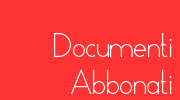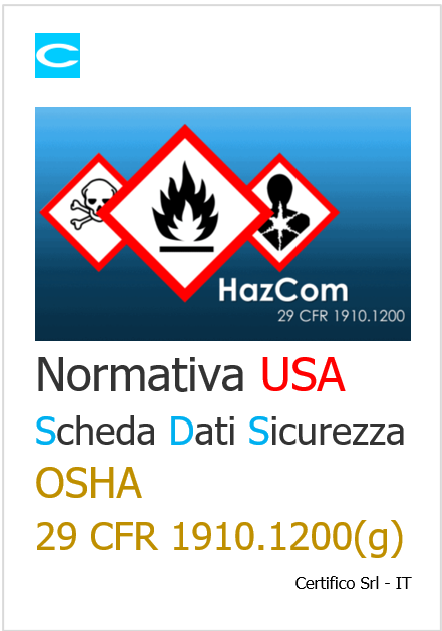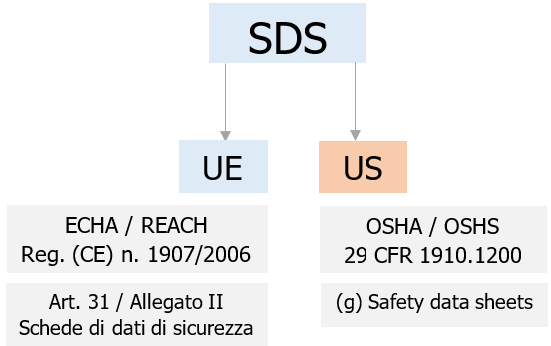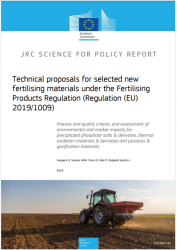La normativa degli Stati Uniti sulle Schede Dati Sicurezza (SDS): OSHA (29 CFR 1910.1200(g))
| ID 23393 | | Visite: 138 | Documenti Riservati Chemicals | Permalink: https://www.certifico.com/id/23393 |
La normativa degli Stati Uniti sulle Scheda dei Dati di Sicurezza (SDS): OSHA (29 CFR 1910.1200(g)) / Note
ID 23393 | 02.02.2025 / In allegato nota completa - Documenti
La normativa internazionale, inclusa quella dell’Unione Europea (ECHA / REACH) e degli Stati Uniti (OSHA / OSHS), richiede che le SDS (Schede dei Dati di Sicurezza) delle sostanze chimiche, siano disponibili nella lingua ufficiale del paese in cui il prodotto chimico è venduto. Questo requisito garantisce che tutte le parti interessate possano comprendere appieno i rischi associati e agire di conseguenza per proteggere se stessi e l’ambiente.
L'Hazard Communication Standard (HCS) dell'OSHA (29 CFR § 1910.1200 Occupational Safety and Health Standards) richiede ai produttori o importatori di sostanze chimiche di classificare i pericoli delle sostanze chimiche che producono o importano. Richiede inoltre a tutti i datori di lavoro di fornire informazioni ai propri dipendenti sulle sostanze chimiche pericolose a cui sono esposti, tramite la comunicazione dei pericoli, etichette e altre forme di avvertenza, schede di sicurezza (SDS), informazioni e formazione.
Istituito nel 1983, l'HCS fornisce un approccio standardizzato alla comunicazione dei pericoli sul posto di lavoro associati all'esposizione a sostanze chimiche pericolose.
L’OSHA ha partecipato attivamente agli sforzi per sviluppare un sistema di comunicazione dei pericoli chimici armonizzato a livello internazionale. È stata promosso, con la sezione 1910.1200 del titolo 29 del CFR (Code of Federal Regulations), uno standard che ha lo scopo di garantire un sistema di classificazione unificato coerente a livello internazionale per la gestione sicura delle sostanze chimiche pericolose e fornire ai lavoratori e ai consumatori di tutto il mondo informazioni su tali sostanze chimiche. Nel 2012, l'OSHA ha ufficialmente armonizzato i suoi standard con la terza revisione del GHS, pubblicata per la prima volta nel 2008.
Nel 2024, l'Amministrazione per la sicurezza e la salute sul lavoro (OSHA) ha aggiornato il suo standard di comunicazione dei pericoli (HCS), 29 CFR § 1910.1200, per allinearlo alla revisione 7 (Rev. 7) del Sistema globale armonizzato di classificazione ed etichettatura delle sostanze chimiche (GHS) delle Nazioni Unite. Le modifiche descritte in 89 Fed. Reg. 44,144 (20 maggio 2024) rivedono i criteri per la classificazione dei pericoli, le disposizioni per l'etichettatura e le concentrazioni dichiarate come segreti commerciali.
La conformità alle nuove disposizioni è prevista in più fasi tra il 19 gennaio 2026 e il 19 gennaio 2028.
Fig. 1 - Schema Authority / Standards UE/US SDS
Schede di sicurezza (29 CFR 1910.1200(g))
La struttura della scheda di sicurezza (SDS) è definita in Europa, dal Regolamento REACH 1907/2006 (Art. 31 / Allegato II) e negli Stati Uniti, dallo Standard OSHA Hazard Communication (29 CFR 1910.1200(g)).
Il formato a 16 sezioni delle SDS fornisce informazioni essenziali sulle proprietà chimiche, sui rischi per la salute, sulle misure di protezione e sulle precauzioni di sicurezza. Imparare a leggere e interpretare queste schede è fondamentale per comprendere la corretta gestione e risposta alle emergenze.
L'Hazard Communication Standard (HCS) richiede ai produttori, distributori o importatori di sostanze chimiche di fornire schede di sicurezza (SDS) per ogni sostanza chimica pericolosa.
L'HCS richiede che le SDS siano in un formato uniforme e includano i numeri di sezione, le intestazioni e le informazioni associate sotto le intestazioni seguenti:
Sezione 2, Identificazione dei pericoli include tutti i pericoli relativi alle proprietà intrinseche della sostanza chimica, tra cui un cambiamento nella forma fisica della sostanza chimica e prodotti di reazione chimica associati a usi o applicazioni noti o ragionevolmente previsti; elementi dell'etichetta richiesti.
Sezione 3, Composizione/informazioni sugli ingredienti include informazioni sugli ingredienti chimici come nomi; numeri Chemical Abstracts Service (CAS) o altri identificatori univoci; intervalli di concentrazione prescritti per le rivendicazioni di segreti commerciali.
Sezione 4, Misure di primo soccorso: include sintomi/effetti importanti, acuti, ritardati; trattamento richiesto.
Sezione 5, Misure antincendio: elenca tecniche di estinzione idonee, attrezzature; pericoli chimici derivanti dall'incendio.
Sezione 6, Misure in caso di rilascio accidentale: elenca procedure di emergenza; attrezzature di protezione; metodi appropriati di contenimento e pulizia.
Sezione 7, Manipolazione e stoccaggio: elenca precauzioni per la manipolazione e lo stoccaggio sicuri, comprese le incompatibilità.
Sezione 8, Controlli dell'esposizione/protezione personale per le sostanze chimiche elencate nella Sezione 3, elenca i limiti di esposizione ammissibili (PEL) dell'OSHA; i valori limite di soglia (TLV) dell'ACGIH; e qualsiasi altro limite o intervallo di esposizione utilizzato o raccomandato dal produttore, importatore o datore di lavoro della sostanza chimica che prepara la SDS, ove disponibile; controlli tecnici appropriati; dispositivi di protezione individuale (DPI).
Sezione 9, Proprietà fisiche e chimiche: elenca le caratteristiche della sostanza chimica, tra cui le dimensioni delle particelle.
Sezione 10, Stabilità e reattività: elenca la stabilità chimica e la possibilità di reazioni pericolose, comprese quelle associate a eventuali emergenze prevedibili.
Sezione 11, Informazioni tossicologiche: include vie di esposizione; sintomi correlati, effetti acuti e cronici; misure numeriche di tossicità; effetti avversi.
Sezione 12, Informazioni ecologiche*
Sezione 13, Considerazioni sullo smaltimento*
Sezione 14, Informazioni sul trasporto*
Sezione 15, Informazioni normative*
Sezione 16, Altre informazioni, include la data di preparazione o l'ultima revisione.
*Nota: poiché altre agenzie regolano queste informazioni, l'OSHA non applicherà le sezioni da 12 a 15 (29 CFR 1910.1200(g)(2)).
29 CFR
Standard Number 1910.1200 - Hazard Communication.
Part Number:1910
Part Number Title: Occupational Safety and Health Standards
[…]
1910.1200(g)
Safety data sheets.
1910.1200(g)(1)
Chemical manufacturers and importers shall obtain or develop a safety data sheet for each hazardous chemical they produce or import. Employers shall have a safety data sheet in the workplace for each hazardous chemical which they use.
1910.1200(g)(2)
The chemical manufacturer or importer shall ensure that the safety data sheet is in English (although the employer may maintain copies in other languages as well), and includes at least the following section numbers and headings, and associated information under each heading, in the order listed (see appendix D to this section, for the specific content of each section of the safety data sheet):
1910.1200(g)(2)(i)
Section 1, Identification;
1910.1200(g)(2)(ii)
Section 2, Hazard(s) identification;
1910.1200(g)(2)(iii)
Section 3, Composition/information on ingredients;
1910.1200(g)(2)(iv)
Section 4, First-aid measures;
1910.1200(g)(2)(v)
Section 5, Fire-fighting measures;
1910.1200(g)(2)(vi)
Section 6, Accidental release measures;
1910.1200(g)(2)(vii)
Section 7, Handling and storage;
1910.1200(g)(2)(viii)
Section 8, Exposure controls/personal protection;
1910.1200(g)(2)(ix)
Section 9, Physical and chemical properties;
1910.1200(g)(2)(x)
Section 10, Stability and reactivity;
1910.1200(g)(2)(xi)
Section 11, Toxicological information.
1910.1200(g)(2)(xii)
Section 12, Ecological information;
1910.1200(g)(2)(xiii)
Section 13, Disposal considerations;
1910.1200(g)(2)(xiv)
Section 14, Transport information;
1910.1200(g)(2)(xv)
Section 15, Regulatory information; and
1910.1200(g)(2)(xvi)
Section 16, Other information, including date of preparation or last revision.
Note 1 to paragraph (g)(2): To be consistent with the GHS, an SDS must also include the headings in paragraphs (g)(2)(xii) through (g)(2)(xv) of this section in order.
Note 2 to paragraph (g)(2): OSHA will not be enforcing information requirements in sections 12 through 15, as these areas are not under its jurisdiction.
1910.1200(g)(3)
If no relevant information is found for any sub-heading within a section on the safety data sheet, the chemical manufacturer, importer or employer preparing the safety data sheet shall mark it to indicate that no applicable information was found.
1910.1200(g)(4)
Where complex mixtures have similar hazards and contents (i.e., the chemical ingredients are essentially the same, but the specific composition varies from mixture to mixture), the chemical manufacturer, importer or employer may prepare one safety data sheet to apply to all of these similar mixtures.
1910.1200(g)(5)
The chemical manufacturer, importer or employer preparing the safety data sheet shall ensure that the information provided accurately reflects the scientific evidence used in making the hazard classification. If the chemical manufacturer, importer or employer preparing the safety data sheet becomes newly aware of any significant information regarding the hazards of a chemical, or ways to protect against the hazards, this new information shall be added to the safety data sheet within three months. If the chemical is not currently being produced or imported, the chemical manufacturer or importer shall add the information to the safety data sheet before the chemical is introduced into the workplace again.
1910.1200(g)(6)
1910.1200(g)(6)(i)
Chemical manufacturers or importers shall ensure that distributors and employers are provided an appropriate safety data sheet with their initial shipment, and with the first shipment after a safety data sheet is updated;
1910.1200(g)(6)(ii)
The chemical manufacturer or importer shall either provide safety data sheets with the shipped containers or send them to the distributor or employer prior to or at the time of the shipment;
1910.1200(g)(6)(iii)
If the safety data sheet is not provided with a shipment that has been labeled as a hazardous chemical, the distributor or employer shall obtain one from the chemical manufacturer or importer as soon as possible; and,
1910.1200(g)(6)(iv)
The chemical manufacturer or importer shall also provide distributors or employers with a safety data sheet upon request.
1910.1200(g)(7)
1910.1200(g)(7)(i)
Distributors shall ensure that safety data sheets, and updated information, are provided to other distributors and employers with their initial shipment and with the first shipment after a safety data sheet is updated;
1910.1200(g)(7)(ii)
The distributor shall either provide safety data sheets with the shipped containers, or send them to the other distributor or employer prior to or at the time of the shipment;
1910.1200(g)(7)(iii)
Retail distributors selling hazardous chemicals to employers having a commercial account shall provide a safety data sheet to such employers upon request, and shall post a sign or otherwise inform them that a safety data sheet is available;
1910.1200(g)(7)(iv)
Wholesale distributors selling hazardous chemicals to employers over-the-counter may also provide safety data sheets upon the request of the employer at the time of the over-the-counter purchase, and shall post a sign or otherwise inform such employers that a safety data sheet is available;
1910.1200(g)(7)(v)
If an employer without a commercial account purchases a hazardous chemical from a retail distributor not required to have safety data sheets on file (i.e., the retail distributor does not have commercial accounts and does not use the materials), the retail distributor shall provide the employer, upon request, with the name, address, and telephone number of the chemical manufacturer, importer, or distributor from which a safety data sheet can be obtained;
1910.1200(g)(7)(vi)
Wholesale distributors shall also provide safety data sheets to employers or other distributors upon request; and,
1910.1200(g)(7)(vii)
Chemical manufacturers, importers, and distributors need not provide safety data sheets to retail distributors that have informed them that the retail distributor does not sell the product to commercial accounts or open the sealed container to use it in their own workplaces.
1910.1200(g)(8)
The employer shall maintain in the workplace copies of the required safety data sheets for each hazardous chemical, and shall ensure that they are readily accessible during each work shift to employees when they are in their work area(s). (Electronic access and other alternatives to maintaining paper copies of the safety data sheets are permitted as long as no barriers to immediate employee access in each workplace are created by such options.)
1910.1200(g)(9)
Where employees must travel between workplaces during a workshift, i.e., their work is carried out at more than one geographical location, the safety data sheets may be kept at the primary workplace facility. In this situation, the employer shall ensure that employees can immediately obtain the required information in an emergency.
1910.1200(g)(10)
Safety data sheets may be kept in any form, including as operating procedures, and may be stored in such a way to cover groups of hazardous chemicals in a work area where it may be more appropriate to address the hazards of a process rather than individual hazardous chemicals. However, the employer shall ensure that in all cases the required information is provided for each hazardous chemical, and is readily accessible during each work shift to employees when they are in their work area(s).
1910.1200(g)(11)
Safety data sheets shall also be made readily available, upon request, to designated representatives, the Assistant Secretary, and the Director, in accordance with the requirements of § 1910.1020(e)
Modifiche da HCS 2012 a HCS 2024 / 29 CFR § 1910.1200
29 CFR § 1910.1200 ( (g)(2)):
Il produttore o l'importatore di sostanze chimiche deve assicurarsi che la scheda di dati di sicurezza sia in inglese (anche se il datore di lavoro può conservarne copie anche in altre lingue) e includa almeno i seguenti numeri di sezione e titoli, nonché le informazioni associate sotto ciascun titolo, nell'ordine elencato nell'Appendice D (Schede di dati di sicurezza - Informazioni minime obbligatorie).
Modifiche all'Appendice D al 29 CFR § 1910.1200- Schede di sicurezza (obbligatorie)
Una scheda di sicurezza (SDS) deve includere le informazioni specificate nella Tabella D.1 sotto il numero di sezione e l'intestazione indicati per le sezioni 1-11 e 16. Mentre ogni sezione della SDS deve contenere tutte le informazioni specificate, i redattori delle schede di sicurezza non sono tenuti a presentare le informazioni in un ordine particolare all'interno di ogni sezione. Se non si trovano informazioni pertinenti per una determinata sottointestazione all'interno di una sezione, la SDS deve indicare chiaramente che non sono disponibili informazioni applicabili. Le sezioni 12-15 possono essere incluse nella SDS, ma non sono obbligatorie.
[...] Segue in allegato
Certifico Srl - IT | Rev. 0.0 2025
©Copia autorizzata Abbonati
Fonte: OSHA
Collegati
Regolamento (UE) 2020/878
Regolamento (UE) 2015/830 REACH - Modifica Allegato II SDS
SDS 2021: Tavola di concordanza
Regolamento (CE) n. 1272/2008 CLP
| Descrizione | Livello | Dimensione | Downloads | |
|---|---|---|---|---|
| La normativa degli Stati Uniti SDS - OSHA 29 CFR 1910.1200(g) Rev. 00 2025.pdf Certifico Srl - Rev. 0.0 2025 |
629 kB | 0 | ||
| Hazard Communication Safety Data Sheets.pdf Quick card |
170 kB | 0 | ||
| Hazard Communication Standard - Safety Data Sheets OSHA.pdf |
576 kB | 0 |
Tags: Chemicals Schede Dati Sicurezza SDS Abbonati Chemicals











































